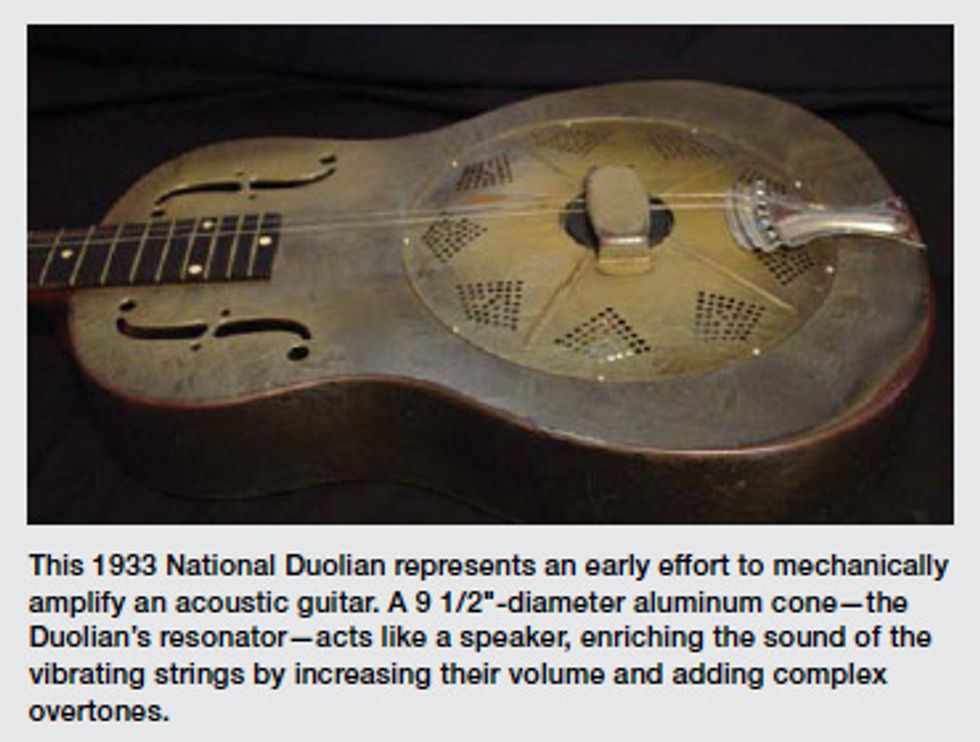A quick look at today’s guitar market shows that acoustic guitars are still outselling electric guitars, and that roughly half of the acoustics being sold have pickup systems already installed by the manufacturer.
When the PG editors asked
me if I would be interested
in writing a quarterly column
on acoustic guitar amplification,
my immediate thought was, this
sounds fun, but another commitment
is clearly not something I
need at this point in time. The
more I thought about it though,
the more the idea began to
appeal to me. Since I have been
designing and manufacturing
acoustic amplification gear for
over 30 years, writing a column
would give me a perfect excuse
to actually sit down, reflect on,
and catalogue my thoughts on
the subject.
A quick look at today’s guitar
market shows that acoustic guitars
are still outselling electric
guitars, and that roughly half
of the acoustics being sold have
pickup systems already installed
by the manufacturer. The number
of acoustic-specific amplification
products—pickups,
preamps, effects pedals, and
amplifiers—that are available
are at an all-time high. It’s very
clear that a large number of
players are focusing on amplifying
their acoustics, but with all
the available choices, deciding
on what works best for you can
be a little daunting. In an effort
to help you select the best gear
for your needs, I’ll first cover a
few amplification fundamentals
and then dig into some details
in each product category. So
let’s get right to it, we have a lot
of ground to cover!

Why amplify in the first place? After all, an acoustic guitar is already an amplifier of sorts—it’s a mechanical amplifier. The source of an acoustic guitar’s sound is the vibrating strings. But when you think about it, without some sort of amplification, the amount of air that the strings can push around is quite small. Additionally, the vibrating motion of the string is sinusoidal in nature, and the resulting sound it creates by itself is a fairly pure tone. While certainly a pretty sound, it’s not really that interesting on its own.
The roles the top of the instrument and the sound chamber play in enhancing the string vibration are huge! They add more volume by pushing a larger amount of air, and they create sonic complexity by adding resonances and overtones to the sound of the vibrating string. Taken together, the result is a louder and richer set of sounds that are able to project into a room. This is why each individual instrument has its own unique and characteristic tone.
Before we decide the best way to further amplify this sound by adding pickups or microphones and amplifiers, it is important to understand the physical operation of the existing mechanical amplifier. Now please stay with me on this—it will be important to understand this later when you are deciding on a system for your instrument. Once you grasp the basic mechanics of an acoustic guitar, you’ll see why many types of pickups can be used to sense its complex vibrational characteristics.
I like to look at it like this: First, when the string is plucked, it creates a string excitation force (SEF) at the saddle. This force is dynamic in nature, in that it changes or pumps in relation to the pulling and relaxing of the string—the string vibration. This ever-changing SEF is then transferred through the saddle to the bridge, which responds in a very interesting way.
Since the top of the instrument is a compliant structure and is often asymmetrically braced, it is going to move when a SEF is applied to it. Now the bridge, being excited by the string, moves with the top. This motion occurs in three primary axes. (Think of a ship on the ocean, where the ship experiences pitch, rolling and heaving as it moves through the waves.)
This complex motion of the bridge causes several things to occur. First, it causes the top to vibrate. The vibrating top moves a lot of air in the room and adds richness and complexity to the sound due to the addition of its own resonances.
Second, the moving top excites the air chamber. The chamber, being a Helmholtz resonator, is designed to resonate at a frequency that enhances the amount of bass energy coming out of the instrument. If you like math, search for “Helmholtz resonance” on Wikipedia.com to learn more.
Third, the moving string support—in this case the bridge—alters the initial vibration pattern of the string due to something we call mechanical admittance. The result is a more complex and interesting overall tone shape.
Before I wrap it up, I’d like to leave you with a simple assignment: Determine what your own guitar really sounds like by having a friend play it for you. If you do this and are surprised that your guitar actually sounds brighter than you expected, don’t feel bad—it’s a very common misconception. Because you are always sitting or standing behind your instrument while you are playing it, and because the higher frequencies are very directional and project away from you, you’re simply not getting the whole picture!
That’s it for now. I’ll be back in a few issues, and that’s when we’ll start looking at the theory of operation for some of the most popular categories of gear.
 Larry Fishman holds
more than 30 patents in
transducer and musical
instrument design. He is
president and founder
of Fishman Transducers,
which he began in his
garage in 1981. In the early ’90s, he
also co-founded and managed Parker
Guitars (which was later sold to U.S.
Music Corp.) with his friend Ken Parker.
Larry Fishman holds
more than 30 patents in
transducer and musical
instrument design. He is
president and founder
of Fishman Transducers,
which he began in his
garage in 1981. In the early ’90s, he
also co-founded and managed Parker
Guitars (which was later sold to U.S.
Music Corp.) with his friend Ken Parker.